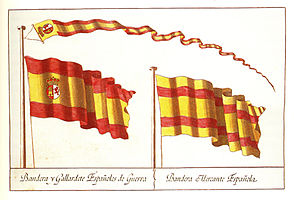Ancient Regime of Spain | |
|---|---|
 Symbols used by the institutions during the last years of the Ancien Régime. | |
| Date formed | circa 15th century |
| Date dissolved | early 19th century |
The Spanish institutions of the Ancien Régime were the superstructure that, with some innovations, but above all through the adaptation and transformation of the political, social and economic institutions and practices pre-existing in the different Christian kingdoms of the Iberian Peninsula in the Late Middle Ages, presided over the historical period that broadly coincides with the Modern Age: from the Catholic Monarchs to the Liberal Revolution (from the last third of the 15th century to the first third of the 18th century) and which was characterized by the features of the Ancien Régime in Western Europe: a strong monarchy (authoritarian or absolute), a estamental society and an economy in transition from feudalism to capitalism.
The characteristics of the Ancien Régime are dispersion, multiplicity and even institutional collision, which makes the study of the history of institutions very complex. The very existence of the institutional unity of Spain is a problematic issue. In this historical period there were unitary institutions: notably, and transcendental in the external perception of the Hispanic Monarchy, the person of the king and his military power; inwardly, the Inquisition. Others were common, such as those inherent to the estamental society: nobility, clergy and corporations of very different types were organized in a way that was not very different in each kingdom. A Catalan Cistercian monastery (Poblet) was interchangeable with a Castilian one (Santa María de Huerta); a Mesteño rancher, with another of the House of Zaragoza; the aristocracy merged into a network of family alliances. But others were markedly different: the Cortes or the Treasury in the kingdoms of the Crown of Aragon had nothing to do with those of Castile and León. Even with the imposition of Bourbon absolutism, which reduced these differences, the Basque provinces and Navarre maintained their fueros. The State and the nation were being forged, largely as a consequence of how the institutions responded to the economic and social dynamics, but they would not present themselves in their contemporary aspect until the end of the Ancien Régime.